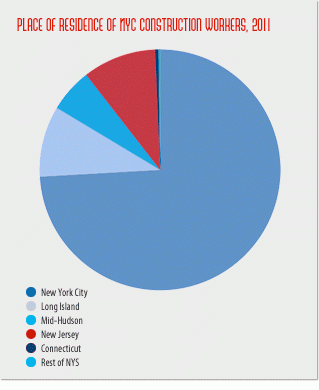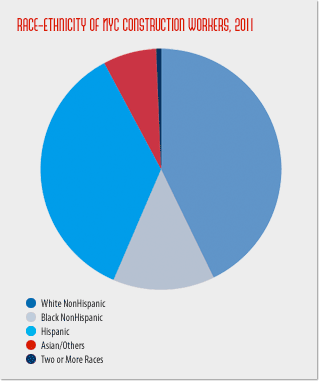
New york building congress analysis finds that 74 percent of building industry workers live in the five boroughs
New York City Residents Likely to be Front and Center in Rebuilding After Hurricane Sandy
Judging from the latest demographic information available on the New York City construction industry, City residents will be the driving force behind the rebuilding of the New York's communities hardest hit by Hurricane Sandy.
A New York Building Congress analysis of the U.S. Census Bureau’s 2011 American Community Survey found that 74 percent of all New York City construction industry workers live within the five boroughs.
As of 2011, there were 224,878 men and women working in New York City’s construction industry. That number is virtually unchanged from 2010. Of those workers, 166,632 (74 percent) live within the City limits. Long Island and New Jersey are each home to approximately 10 percent of the City workforce, while 6 percent live in the Mid-Hudson Valley.
In addition, more than half of the overall construction workforce (51 percent) live in Queens (64,225 workers) and Brooklyn (49,582). Another 15,292 workers are Staten Island residents.
“One purely practical effect of the storm and its aftermath is more construction-related jobs for New Yorkers,” noted New York Building Congress President Richard T. Anderson. “But far more important are the civic and emotional aspects of what lies ahead. As we saw after 9/11, the men and women of the building community have a deep and abiding commitment to New York City and want nothing less than to be an integral part of our collective response to the storm. That desire will be all the more intense for the thousands of Brooklyn, Queens and Staten Island workers whose neighborhoods, families and friends bore the brunt of the storm’s devastation.”
Demographics of the Building Community
The Building Congress analysis is based on personal responses to the Census Bureau survey and incorporates both union and non-union labor, as well as management positions, architects, engineers, office support and other service workers connected to the construction industry. Because the results are self-reported by individuals rather than by employers, the survey captures the participation of “off-the-books” workers throughout the industry. The census data includes both white-collar and blue-collar positions in private firms and on government payrolls.
In 2011, White Non-Hispanic men and women accounted for 96,249 (43 percent) of the 224,878 workers. Hispanics made up 80,331 (36 percent) of the total workforce, followed by Black Non-Hispanics at 30,720 (14 percent) and Asian workers at 16,085 (7 percent). Less than one percent identified themselves as multi-racial.
Additional 2011 demographic statistics on the New York City construction industry workforce include:
- The construction trades accounted for 165,827 jobs (74 percent of the total construction workforce).
- The percentage of trades workers with health insurance rose slightly – from 44.7 percent in 2010 to 47.4 percent in 2011.
- Nearly half of all construction industry workers (47 percent) lived in households with incomes between $50,000 and $125,000 in 2011. Ten percent of all workers self-reported household earnings of less than $25,000 annually.
- 56 percent of all respondents said they speak a language other than English in their homes. After English speakers, the most prevalent languages are Spanish (34 percent), Polish (3.5 percent) and Chinese (2.9 percent).
- 61 percent of all construction industry workers never attended college.
- Construction remains a male-dominated industry, with men accounting for 93 percent of all workers.
- 53 percent of all industry workers are over 40 years-old, while 18 percent are under 30.
“New York City’s construction industry has been and remains a vital source of meaningful employment opportunities for recent immigrants and residents of all educational backgrounds,” said New York Building Congress President Richard T. Anderson. “In order to maintain a robust and dynamic workforce, however, the building community may need to step up its support of those industry organizations devoted to increasing employment, mentoring and advancement opportunities for area women and young adults.”
Charts and Diagrams

Source: U.S. Census Bureau's 2011 American Community Survey

Source: U.S. Census Bureau's 2011 American Community Survey
Raw Data



